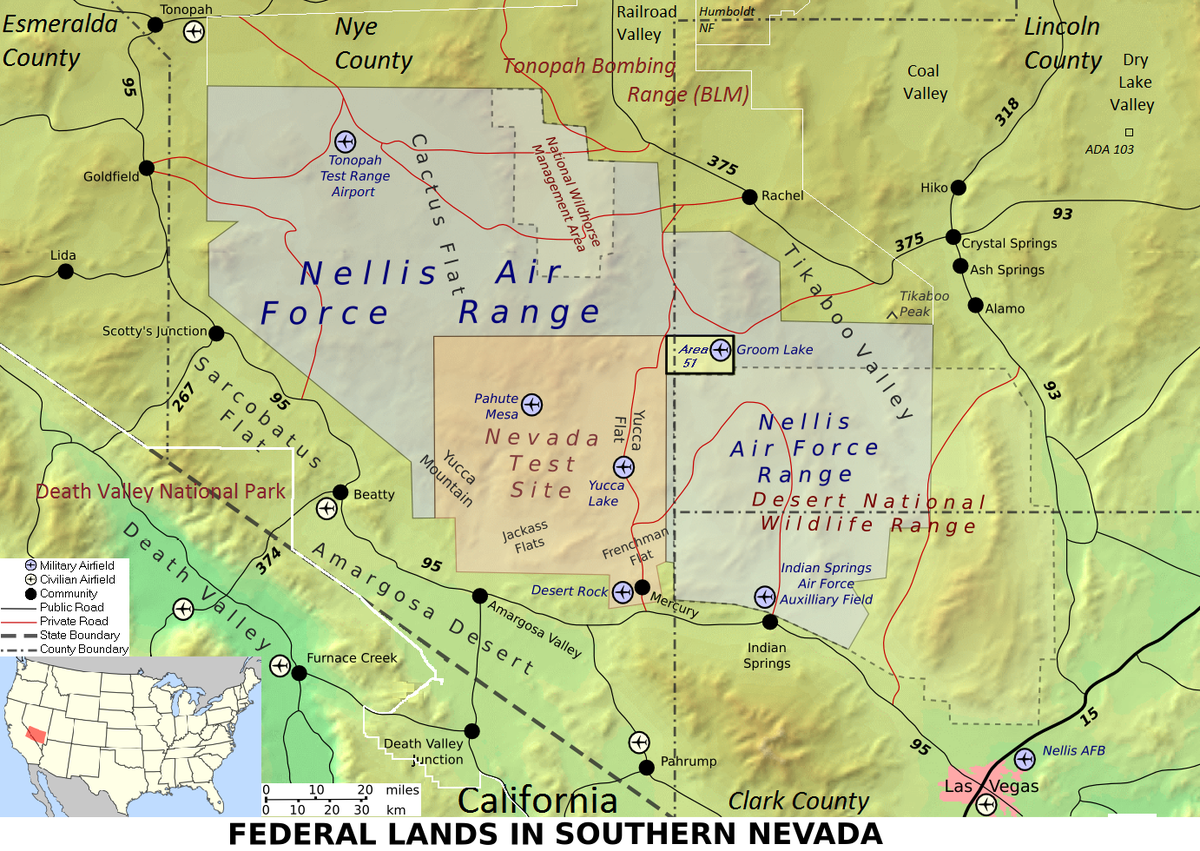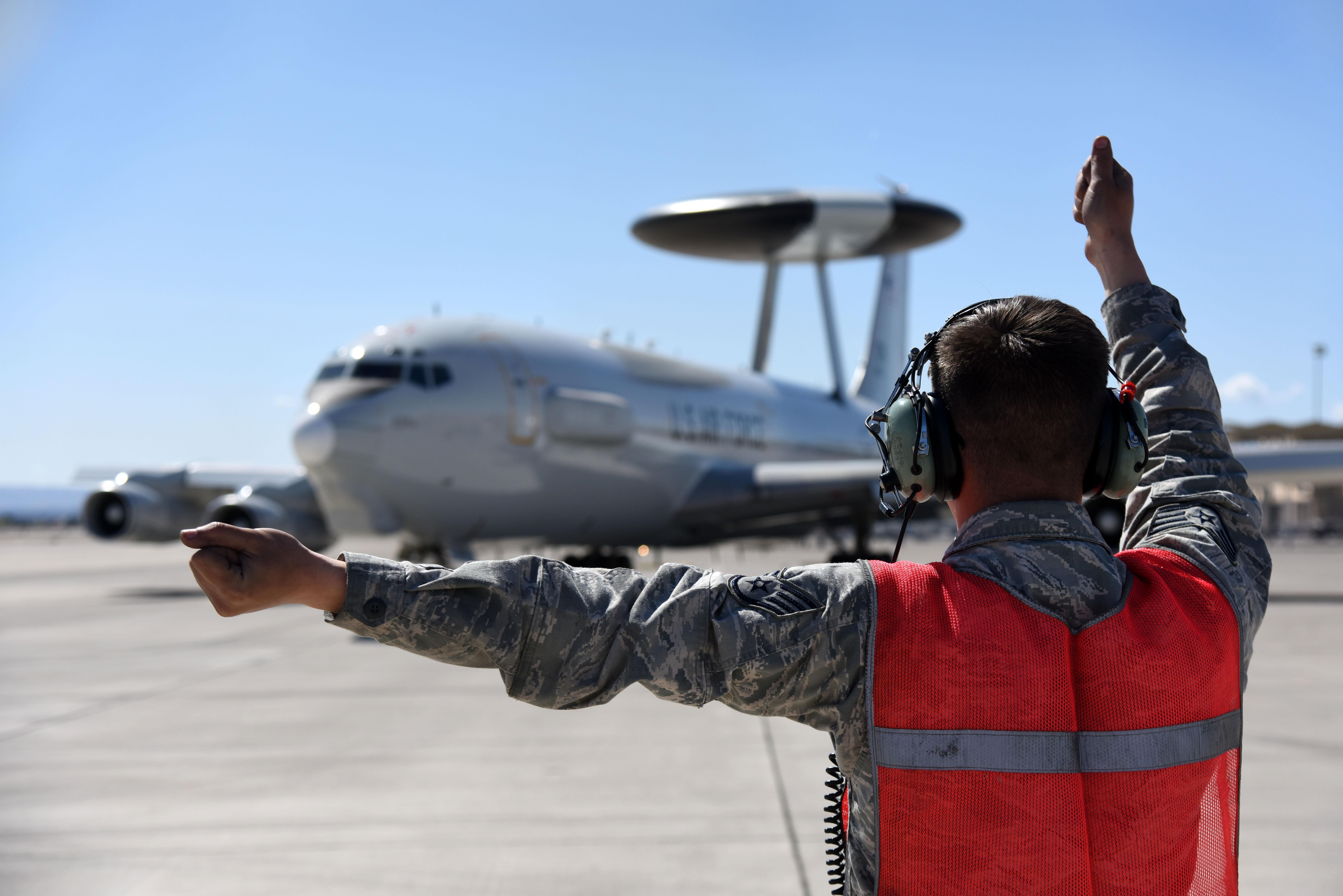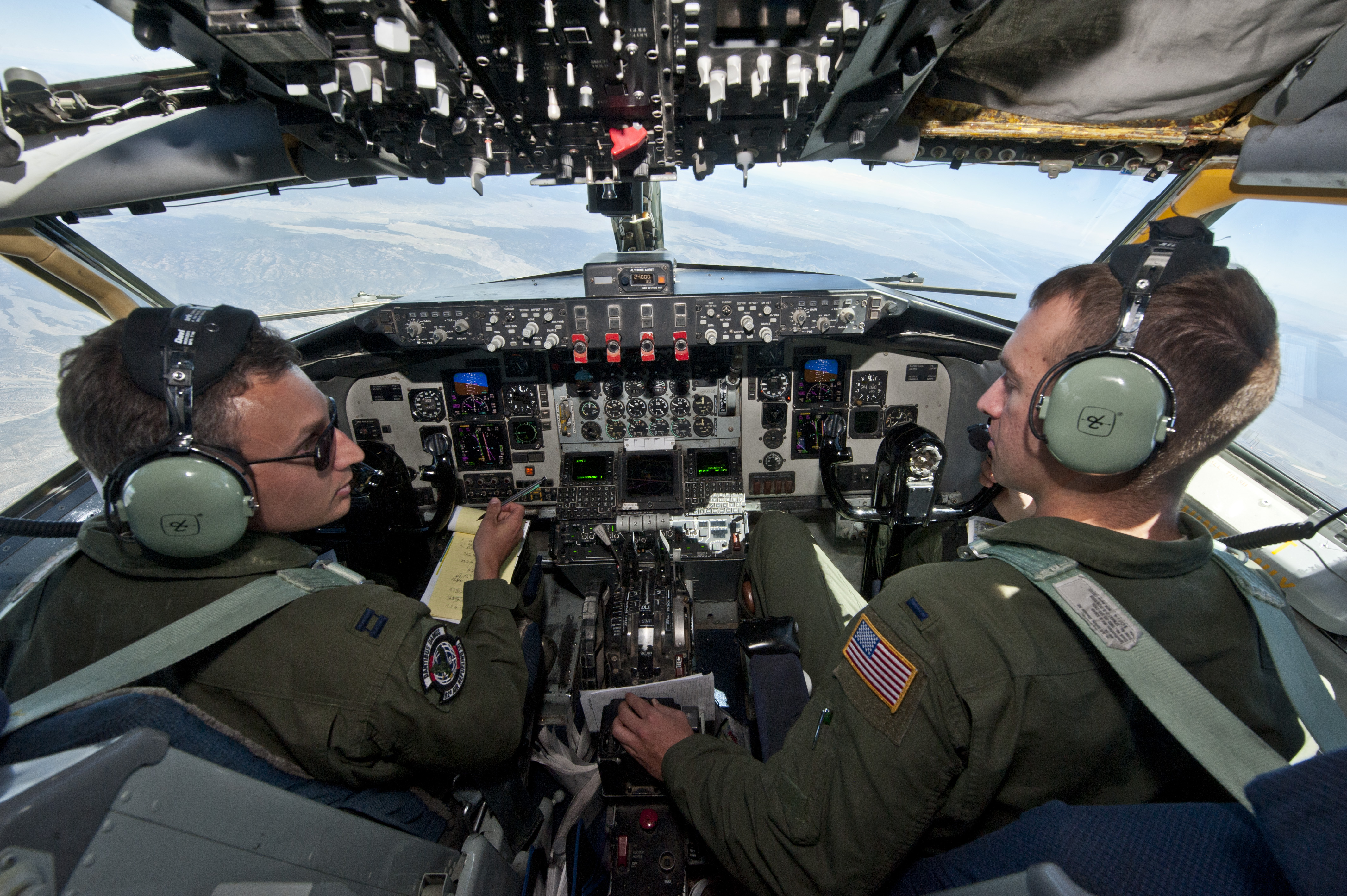
ST. GEORGE — Southern Utahns may have been wondering about mysterious sights in the sky recently, and over the next couple months, St. George News will most certainly hear from multiple readers asking about random booms and shakes. Well, we have the answers, and it turns out to be two-fold.
The Iron County Sheriff’s Office said Friday that after receiving calls over the last few days concerning low-flying military-style aircraft in the Southern Utah sky, it contacted the Federal Aviation Administration.

“The FAA has reported back to us (that) Nellis Air Force base has an FAA-approved low-flying flight route in our area,” the Sheriff’s Office said.
That route starts at the Black Ridge on Interstate 15 and runs north to Beaver, then turns west and heads out to Nevada, officials said, adding that the route is for training purposes only.
In addition to the low-flying training route, the United States Air Force kicked off its largest three-week premier air-to-air combat training exercise Friday, known as “Red Flag 18-1.”
From 100 feet above the ground to twice the speed of sound
Increased military aircraft activity
Red Flag is a realistic combat high-intensity training exercise coordinated at Nellis Air Force Base located north of Las Vegas in Nevada and conducted on the vast bombing and gunnery ranges of the Nevada Test and Training Range. The range is the Air Force’s premier military training area, with more than 15,000 square miles of airspace and 2.9 million acres of land.
Base officials are reminding residents of the surrounding areas that they will notice increased noise and military aircraft activity due to more than 80 aircraft scheduled to depart Nellis twice a day and remaining in the air for up to five hours during Red Flag, according to a Noise Advisory issued by the Air Force.

There may be night launches as well to allow air crews to train for nighttime combat operations.
“We’re trying a few new and different things with Red Flag 18-1,” Col. Michael Mathes, 414th Combat Training Squadron commander, said in a statement. “It’s the largest Red Flag ever with the largest number of participants, highlighting the balance of training efficiency with mission effectiveness.”
Southern Utah residents can expect to hear booms, shakes and rattling for the duration of the mock battle in the skies running through Feb. 16 and again March 9-23.
Previously, the rattle was reportedly strong enough to break the windows of some St. George residents in SunRiver.
More than 75 percent of all live munitions used by the United States Air Force for training are dropped on the Nevada Test and Training Range west of St. George.
A typical Red Flag exercise involves a variety of attack, fighter and bomber aircraft: F-15E, F-16, F/A-18, A-10, B-1 and B-2; reconnaissance aircraft: Predator, Global Hawk, RC-135 and U-2; electronic warfare aircraft: EC-130s, EA-6Bs and F-16CJs; air superiority aircraft: F-22 and F-15C; airlift support: C-130 and C-17; search and rescue aircraft: HH-60, HC-130 and CH-47; aerial refueling aircraft: KC-130, KC-135 and KC-10; command and control aircraft: E-3, E-8C and E-2C, as well as ground-based command and control, space and cyber forces.

“Blue” forces utilize the diverse capabilities of their aircraft to execute specific missions, such as air interdiction, combat search and rescue, close air support, dynamic targeting and defensive counter air, according to the Air Force. These forces use various tactics to attack NTTR targets such as mock airfields, vehicle convoys, tanks, parked aircraft, bunkered defensive positions and missile sites.
These targets are defended by a variety of simulated “Red” force ground and air threats to give participant aircrews the most realistic combat training possible.
GPS disruption
To challenge aircrews and their weaponry under realistic fighting conditions, the Air Force will reportedly blackout GPS over the Nevada Test and Training Range. The tactics are expected to impact the region. Warnings have indicated that inconsistent GPS service could be experienced by aircrews flying throughout the western United States.
Coinciding with Red Flag 18-1, the disruptions will begin on Jan. 26 and will run through Feb. 16, Flying.com reports:
The NBAA Command Center reports the U.S. military will begin training exercises on the Nevada Test and Training Range between 0400Z until 0700Z daily. Training maneuvers will impact vast portions of the Western U.S. including California, Nevada, Oregon, Wyoming, Arizona, Utah, Colorado, Montana and New Mexico. FAA enroute ATC centers affected include Albuquerque (ZAB), Denver (ZDV), Los Angeles (ZLA), Salt Lake (ZLC), Oakland (ZOA) and Seattle (ZSE). Operations in R-2508 and R-2501 may also be impacted.
Arrivals and departures from airports within the Las Vegas area may be issued non-Rnav re-routes with the possibility of increased traffic disruption near LAS requiring airborne re-routes to the south and east of the affected area. Aircraft operating in Los Angeles (ZLA) center airspace may experience navigational disruption, including suspension of Descend-via and Climb-via procedures. Non-Rnav SIDs and STARs may be issued within ZLA airspace in the event of increased navigational disruption. Crews should expect the possibility of airborne mile-in-trail and departure mile-in-trail traffic management initiatives.
A “White” force in Red Flag uses the Nellis Air Combat Training System to monitor the mock combat between Red and Blue. According to the Air Force, the training system is the world’s most sophisticated tracking system for combat training exercises and allows commanders, safety observers and exercise directors to monitor the mission and keep score of simulated “kills” while viewing the simulated air battle as it occurs.

As Red Flag expanded to include all spectrums of warfare – command, control, intelligence, electronic warfare – and added night missions to each exercise period, the combination of the Nellis Air Combat Training System, improved tactics and increased aircraft/aircrew capabilities improved flying safety.
“Red Flag remains a great mix of heritage and future potential,” Mathes said. “We are very proud of our heritage with the way that red flag had improved survivability and readiness over the years. We look forward as we continue to grow readiness through integrated training as well as improving training efficiency.”
The exercise typically involves participants from the U.S. Air Force, U.S. Navy, U.S. Army, Marine Corps, Royal Australian Air Force and Royal Air Force.
“With approximately 2,200 targets, realistic threat systems and an opposing enemy force that cannot be replicated anywhere else in the world, Nellis and the NTTR provide combat air forces with the ability to train to fight together, survive together and win together,” according to a statement from the United States Air Force.
Read more: Here comes the BOOM: What’s shaking, rattling Southern Utah?
Click on photo to enlarge it, then use your left-right arrow keys to cycle through the gallery.

Four F-22 Raptors assigned to the 95th Fighter Squadron at Tyndall Air Force Base, Fla., sit on the flightline at Nellis Air Force Base, Nev., in preparation for Red Flag 17-3 July 7, 2017. This exercise gives Airmen an opportunity to experience realistic combat scenarios to prepare and train them in the event of future conflicts or war. | Photo courtesy of U.S. Air Force, St. George News

An F-22 Raptor, from Joint Base Langley-Eustis, Va., receives fuel from a KC-135 Stratotanker over the Nevada Test and Training Range in a training sortie during Red Flag 16-3, July 21, 2016. Red Flag, which is conducted by the 414th Combat Training Squadron at Nellis AFB, is a realistic combat training exercise involving the air forces of the U.S. and its allies that maximizes the combat readiness and survivability of participants by providing a realistic training environment. | Photo courtesy of U.S. Air Force, St. George News

F-35Bs, assigned to the 3rd Marine Aircraft Wing, Marine Corps Air Station Yuma, Az., sit on the flightline during Red Flag 16-3 at Nellis Air Force Base, Nev., July 12, 2016. This Red Flag marks the first time Marine F-35s will be participating in Red Flag. | Photo courtesy of U.S. Air Force, St. George News

In this 2016 file photo, Staff Sgt. Joshua Free, a dedicated crew chief assigned to the 28th Aircraft Maintenance Squadron, Ellsworth Air Force Base, S.D., checks the metal structure of a B-1 Lancer prior to a Red Flag 16-2 night training sortie March, 10, 2016, at Nellis Air Force Base, Nevada | Photo courtesy of U.S. Air Force, St. George News

Staff Sgt. Christopher Longueira, 552nd Aircraft Maintenance Squadron dedicated crew chief, marshals an E-3 Sentry to the runway March 8, 2016, during Red Flag 16-2 at Nellis Air Force Base, Nevada. The radar and other sensors aboard the E-3 provide deep-look surveillance, warning, interception control and airborne battle management. | Photo courtesy of U.S. Air Force, St. George News

An F-14E Strike Eagle assigned to the 389th Fighter Squadron from Mountain Home Air Force Base, Idaho, takes off during Red Flag 15-3 at Nellis AFB, Nev., July 21, 2015. Aircraft and personnel deploy to Nellis for RED FLAG under the Air Expeditionary Force concept and make up the exercise's "Blue" forces. By working together, these Blue forces are able to utilize the diverse capabilities of their aircraft to execute specific missions, such as air interdiction, combat search and rescue, close air support, dynamic targeting and defensive counter air. | Photo courtesy of U.S. Air Force, St. George News

An F-15E Strike Eagle assigned to the 391st Fighter Squadron, Mountain Home Air Force Base, Idaho, takes off during Red Flag 15-3 at Nellis AFB, Nev., July 21, 2015. Red Flag provides a series of realistic air-to-air combat exercises which prepare warfighters for future real-world operations. | Photo courtesy of U.S. Air Force, St. George News

An F-15C assigned to the 122nd Fighter Squadron, Louisiana Air National Guard, banks after refueling from a KC-135 Stratotanker during a Red Flag 15-3 training mission over the Nevada Test and Training Range, July 24, 2015. Different units from across the Department of Defense and allied nations come to Red Flag to train in intense air-to-air combat scenarios which will prepare them for future real-world operations. | Photo courtesy of U.S. Air Force, St. George News

In this 2015 file photo, Capt. Taylor Ellington and 1st Lt. Matthew Street, both pilots assigned to the 92nd Air Refueling Wing, Fairchild Air Force Base, Wash., discuss notes while flying a Red Flag 15-3 training mission over the Nevada Test and Training Range, July 24, 2015. During Red Flag, KC-135s circle the skies refueling fighter aircraft to expand their training missions. | Photo courtesy of U.S. Air Force, St. George News

Two F-22 Raptors assigned to the 95th Fighter Squadron, Tyndall Air Force Base, Fla., fly in formation as they wait on a fellow wingman to finish refueling from a KC-135 Stratotanker assigned to the 22nd Air Refueling Wing, McConnell AFB, Kan., during a Red Flag 15-3 training mission over the Nevada Test and Training Range, July 24, 2015. KC-135s are responsible for refueling all aircraft during Red Flag with approximately 20 units participating in 15-3. | Photo courtesy of U.S. Air Force, St. George News

Pilots from Shaw Air Force Base, S.C., and Spangdalam Air Base, Germany wait for take off while pre-flight checks are performed on their aircraft on the flightline at Nellis Air Force Base, Nev., July 23, 2015. Units from around the world came to experience and participate in the best training they can receive in the air, space and cyberspace realm of operations. | Photo courtesy of U.S. Air Force, St. George News

An F-22 Raptor from the 325th Fighter Squadron, Tyndall Air Force Base, Fla., banks and departs after refueling off the tail of a KC-135 Stratotanker assigned to the 344th Air Refueling Squadron, McConnell Air Force Base, Kan., during a Red Flag 15-3 training sortie over the Nevada Test and Training Range, July 24, 2015. This year marks the 40th anniversary of the Red Flag exercise, during which units from around the U.S. and allied militaries integrate capabilities fighting through complex air, space, and cyber warfare training scenarios. | Photo courtesy of U.S. Air Force, St. George News
Email: [email protected]
Twitter: @STGnews
Copyright St. George News, SaintGeorgeUtah.com LLC, 2018, all rights reserved.
Amen. Love to catch a glimpse of these guys.
Enjoy your cracked stucco & windows on your new houses for all you folks just moving to the state…happens each and every year…oh, your Real estate agent forgot to tell you about that huh? Oh, did they mention the Earthquake faults here? No?…oh sorry
No cracked stucco or windows in 20 years. Filling a crack of replacing a window is a small price to pay for a free America.
Oh please enough of the cracked window and cracked plaster whining it’s all so fake.. I love the sound of freedom. FLY BOYS FLY
The sound of freedom!
Amen!
Carry on Troops!!!
God Speed.
I didn’t know the sheriffs office could talk – lol!
Correction to one of the photo captions: Though I’m not 100% sure which aircraft is depicted, it looks the same as an F-15.
However, the caption reads “F14E Strike Eagle”. As far as I know, F14s are called Tomcats, and the only fighter plane called a Strike Eagle is the F15, So I think it should maybe be changed to F15E Strike Eagle in that caption.